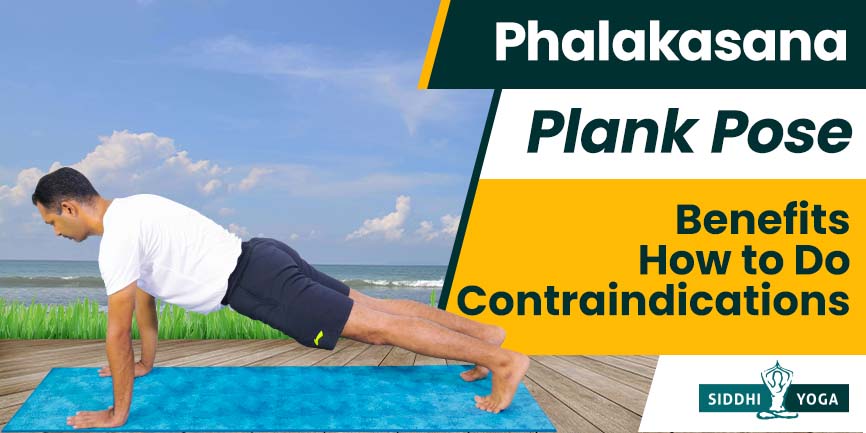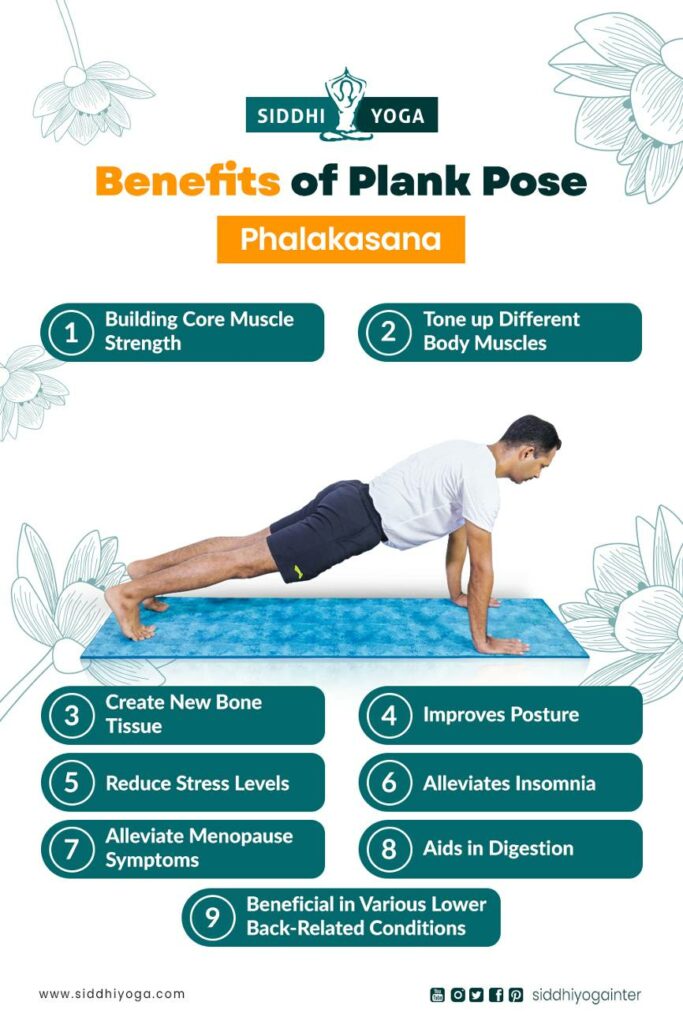
āsana: “posture”
Phalakasana at a Glance
Phalakasana looks like a Plank, also called a Plank Pose, which helps to strengthen the core, shoulder blades, arms, and back muscles. There are other names- Kumbhakasana, Santolasana, and Dandasana. This pose is supported on four points (two feet and palms).
Benefits:
- It strengthens the lower back muscles.
- It builds the upper body and the core strength.
- It helps to strengthen your upper arms, shoulders, and wrists.
- It is a foundation for arm balances.
Who can do it?
The plank pose is a beginner pose. People with normal health conditions can do this asana. People who want to improve their balance and core strength can do this pose. People who need to increase their lower back strength and strengthen their arms and legs can do this pose.
Who should not do it?
People with wrist, shoulder, or back injuries should avoid doing the Plank pose. People with High BP or Carpal tunnel Syndrome should avoid doing it or check with their healthcare professionals. Pregnant women should avoid going this Plank pose. People with any recent surgeries should avoid or contact their doctor.
How to Do Phalakasana?
Follow the Step-by-Step Procedure
Kumbakasana is about discovering your inner strength and balancing your whole body and mind.
- Start on an even, soft surface to avoid hurting your body parts and focus on the Plank pose.
- Start the Plank Pose asana by coming on your fours on the ground (on hands and knees.) or a simple tabletop pose. Your wrists should be below your shoulders and your knees should be aligned to your hips.
- Remember to place your fingers wide on the mat and firm your outer arms for better support. See that your fingers are straight and your middle finger should be forward.
- Bring your right leg back and toes, pushing and tucked to the floor, and then bring your left leg back and level it to your right leg. Legs should be hip-width apart.
- This is the push-up position; your body should be in one straight line from head to heel.
- Your body should be away from the floor, squeeze your inner thighs and engage your core.
- Don’t let your hips drop or lift and your neck should be in line with the spine and look forward,
- Keep breathing gently throughout the poses.
- You can hold the Plank pose within your comfort level and gradually increase when you acquire more core strength.
- Alignment is vital to maintain a proper posture and avoid hurting.
- When you want to come out of the Plank pose, gently bring your knees down to the ground and relax and feel the strength of all the body parts.
- Come to the child pose to cool your body and relax your mind.
- It is very important to listen to your body and use props or modify to a simpler version with the help of your yoga teacher.
What are the Benefits of Phalakasana?
The Plank pose has numerous physical and mental benefits, which build your outer and inner self-confidence, strengthen you in all ways, and keep you balanced.

- The Plank pose is amazing to build your core muscle strength. This pose targets your abdominal muscles and tones and strengthens them, including the rectus abdominis, obliques, and transverse abdominis. This improves your posture and helps to relieve your back pain.
- Arms and shoulders support the front part of your body weight, while during this pose, it helps to strengthen your upper body and triceps.
- This Plank pose improves your balance and stability as you need to maintain a straight line from your head to your heels. This helps to strengthen the coordination and balance between your mind and body.
- The plank pose helps for a neutral spine alignment, helps maintain spinal health, and reduces the stress and tension from the back.
- Once you practice the Plank pose and bring it into your routine, it helps to strengthen your core and the upper body, helps you become aware of the posture and helps to reduce slouching your back.
- This helps mindfulness and deep breathing, which reduces stress and anxiety.
- This can help make the everyday activities of your life easy as this builds muscular and mental endurance with regular practice.
- This can also be included with various fitness routines.
- This can be taken as a base pose and once you get this into your everyday routine you can challenge other advanced yoga poses that build your core and upper body strength.
Also See: Online Yoga Teacher Training
Health Conditions that Might Benefit from Phalakasana
- The plank pose would be helpful for people who are looking to strengthen their arms, wrists, and the muscles around the shoulders and the upper back.
- People having digestive or regular constipation issues can get help as these massages put pressure on the abdominal system and help with bloating and gas.
- It increases blood circulation, tones your muscles and helps build stamina.
- You can include this in your yoga or any exercise routine if you want to improve your posture.
- People with a weak core can practice the Phalakasana yoga pose to strengthen their abdominal muscles.
- People suffering from stress and anxiety can practice this pose regularly with mindful breathing and focus on their inner and outer balance.
- This could help people to improve their focus and concentration, which improves their mental clarity.
- This asana can help People with weak bone health and osteoporosis as this pose carries your body weight on your arms and feet and helps strengthen your bones.
Safety and Precautions
- Anyone injured in their wrist, arms, shoulders, ankles, or foot and any recent surgery should avoid doing this Plank pose.
- Phalakasana needs to have good breath coordination, so people with any breath issues should avoid or can take the help of their yoga teacher, and don’t forget to consult your doctor.
- Some people have very weak wrists and ankles, so they should avoid doing it or may end up damaging it.
- Pregnant women and senior citizens should avoid doing it.
- See that your wrist and shoulder are in one line.
- If you are a beginner, make it slow and follow the indication given by your body.
Common Mistakes
- Not maintaining the alignment from the head to heel when in pose.
- Always do warm-up preparatory poses before starting this pose.
- Do a Plank pose on a soft and even surface.
- Keep your back in a straight line. Don’t arch or hunch your back or let your hips sag.
- Core leads this asana, so you must engage your core to make the pose effective.
- Shoulder blades should be firm and arms straight.
- Don’t hold your breath. Keep breathing gently.
- Don’t try to ignore if you feel any discomfort in your body.
Tips for Phalakasana
- Making warm-up as a workout before any asana can help with any possible strain or cramp.
- Do the Plank pose on an empty stomach or after 4 to 5 hours.
- Avoid doing the Phalakasana pose if your stomach is upset.
- For beginners, it is better to do it under the guidance of a yoga trainer.
- If you have any mild issues, you can modify them accordingly.
- Everybody has limitations and flexibility, so respect your body, listen to the signs and follow accordingly.
- Make slow progress rather than straining your body and hurting yourself. Be and steady.
- You can include Phalakasana with the sequence of other asana to make a flow.
The Physical Alignment Principles for Phalakasana
- Proper alignment is important for a safe yoga pose.
- Start with Table pose as the base.
- See that your wrists are directly under your shoulder blades.
- Fingers are wide and palms firm.
- Don’t hunch your shoulders.
- Engage your core muscles while in the pose.
- Your back from head to heel should be in one line.
- Legs should be hip-width apart and straight.
- Hips shouldn’t sag and don’t hunch your neck or arch it.
- Breathe gently and steadily. Don’t hold your breath.
Phalakasana and Breath
- The formula for breathing in this Plank pose is to keep it gentle, natural, and steady.
- Breathe deeply as you enter the pose, exhale slowly, and then breathe naturally and mindful.
- When you hold the pose, let your breath be calm and relaxed and not make it tense. Inhale and exhale gently as you hold the pose and not the breath; breath has to keep flowing to the entire body and you get recharged by the new energy.
- Breathing naturally will help you focus on yourself as you strengthen your core, arms, wrists, thighs, shoulders, and legs. Breath is your guide and friend for this Plank asana. So, coordinate with it properly and avail all the benefits.
Phalakasana and Variations
- You can modify it to simplify it if you are a beginner.
- Instead of keeping the upper body weight to the palm, you can rest your forearms on the ground and your elbows below the shoulder. This is the forearm plank pose.
- You can also modify the plank pose with your knees bent on the floor and upper body on the palms.
- You can do a plank pose with the right and repeat with the other leg.
- Downward-facing dog.
- Plank pose knee to elbow.
Take Away
The plank is an excellent yoga posture for beginners because it helps to build strength in the arms, shoulders, core, and legs. It’s also beneficial for weight loss as it burns calories quickly. In addition, it increases your stamina and enhances your metabolism. When practiced regularly, the plank can help improve overall stability and balance.
Unlock the door to a fulfilling career in yoga instruction with our accredited yoga teacher training courses. Choose from our foundational 200 Hrs Yoga Teacher Training Course, advanced 300 Hrs Yoga Teacher Training Course, or the all-encompassing 500 Hrs Yoga Teacher Training Course – all certified by Yoga Alliance, USA. Immerse yourself in the world of yoga philosophy, anatomy, teaching methodologies, and more. Embrace this opportunity to become a certified yoga instructor and inspire others on their path to wellness. Enroll now and embark on a transformative journey!
Responses